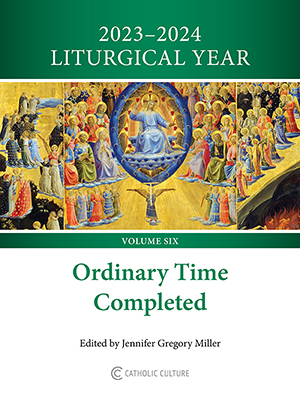Establishing Intentional Liturgical Living Routines
By Jennifer Gregory Miller ( bio - articles - email ) | Sep 30, 2022 | In The Liturgical Year
My oldest son just celebrated his birthday last week. He’s a freshman at college, and this was his first birthday away from home. Since he was still adjusting to his new environment, I wanted to make sure he felt loved and remembered on his birthday, giving him a little piece of family and home for the day.
I mentally went through our birthday family routines, trying to figure out which of our family traditions would be the touchstones he would want for his birthday. Included in the plan was a special allergy friendly birthday cake made and delivered by a friend as a surprise, and we sent cards and packages.
As I went through our routines, I started thinking how we kept them simple, but these were the deliberate skeleton plan that made family birthdays special. If an aspect was missing, our sons always pointed it out.
This is the same approach I took for our living the Liturgical Year, or “Liturgical Living.” We put a few routines in place. These were visible and kind of a guide to help us celebrate throughout the year, but not always having to reinvent the wheel and come up with new ideas every feast. Once we had some parameters in place, it was comforting both for the parents, knowing the expectations, and for the children, feeling the comfort in routines. I think lately the idea of “Liturgical Living” has now gotten too complicated and this is just a reminder that it’s easy and a good thing to establish a deliberate but simple family routines.
Birthday Routines
Our established birthday skeletal plan had these elements:
Beforehand:
- Hang Happy Birthday banner over kitchen table.
- Write and hang birthday poster with poem in hallway.
- Wrap gifts, put on kitchen table.
- Sign and seal birthday cards.
- Bake a birthday cake.
Birthday:
- Go to Mass together as a family, pray for the birthday person.
- Special dinner—either restaurant of choosing or favorite dinner at home.
- Light candles on cake and sing, serve cake and ice cream.
- Open presents.
For our sons, birthdays meant new Lego sets, so the day also included time for building Legos.
These traditions are nothing original but part of our family’s routine.
Nameday Routines
We make namedays a special day for our family, too. I admit I deliberately chose names that had feast days around the year so our sons could celebrate their name saints! I enjoyed listening to the Foleys talk about their nameday traditions in the Drinking with the Saints Podcast, as it was comforting to know we had similar approaches in place.
Our routine is a bit similar follows a little of the birthday plan:
- Go to Mass together as a family and pray for the nameday person.
- Often, a special breakfast together, or a donut treat.
- Special dinner—either restaurant of choosing or favorite dinner at home.
- Special dessert of their choosing.
Sometimes the list has been abbreviated to a special treat for the day, and sometimes it’s been expanded with a special gift for the nameday.
Expanding to Around the Year
The rest of the year celebrations circle around the family feasts. Wedding anniversaries, baptism and First Communion anniversaries, death anniversaries….when these show up on the calendar, our first routine is to start the day going to Mass, with the intention of praying for those persons we are remembering. And for the happy celebrations, we add a little treat.
For the feasts and saints’ days throughout the Liturgical Year, we established a routine that helped the family see the variety of the liturgical seasons and feasts, and how the Church marks celebrating in different ways.
- Solemnities meant going to Mass as a family. Since I’m the usual cook, solemnities often meant a night out of the kitchen, and then a special dessert. We would pray the rosary together at the end of the day.
- When I homeschooled, we also tried to attend Mass on Feasts. These didn’t look as celebratory at home, but we discussed the feasts and perhaps had something special for dinner that reminded us of that saint.
- Memorials and Optional Memorials were celebrated with “extensions” if they had special significance or personal preference to someone in the family.
Simple Parameters
Really, liturgical living is about deliberately establishing simple guidelines, making it easy to check the boxes. We have an intentional outline that we can fill in:
- Liturgy and Prayer (Mass, rosary)
- Food
- Family Time
- Visual Display (photos, signs, holycards)
- Oral or written saint biography, retelling of baptismal day events, etc.
I know I talk about food as being one of the main elements in our feast day living, but with a husband and two sons, they do like food, and meals are our main gathering time. That was working with one of their love languages!
Choose Wisely!
One little note: Definitely think carefully and choose wisely when you establish a tradition or routine. Your children love them, and when it goes away, they notice it. But don’t choose something that is hard to recreate every year.
Every birthday I would make a birthday poster, so that would be the first thing they saw when my sons came out of their rooms. For their first years, I always wrote a little rhyming poem. There were some birthdays when, trying to compose a poem at midnight, I really regretted being so “creative” in my celebration. I eventually made the new routine that once you are a teenager, no more poems, just a birthday poster!
I know this has been one of the touches that has been a favorite of theirs. I have had a poster or two made for me, in the same style. And I included in my son’s college birthday box a simple large handmade card, reminiscent of the birthday poster, and he commented on how that was the perfect touch.
Proceed with this little caveat: choose wisely (and conservatively)!
Simple Routines, Happy Family
Lately it just feels like we need to return to simplicity. Living the Liturgical Year shouldn’t be complicated. Establishing deliberate, simple routines gives guidelines and a backdrop. It provides comfort for the family, knowing what to expect, but also room for creativity. Giving wide margins provides room for other family members to add their own personal touches. Let’s return to Uncomplicated Liturgical Living!
All comments are moderated. To lighten our editing burden, only current donors are allowed to Sound Off. If you are a current donor, log in to see the comment form; otherwise please support our work, and Sound Off!








